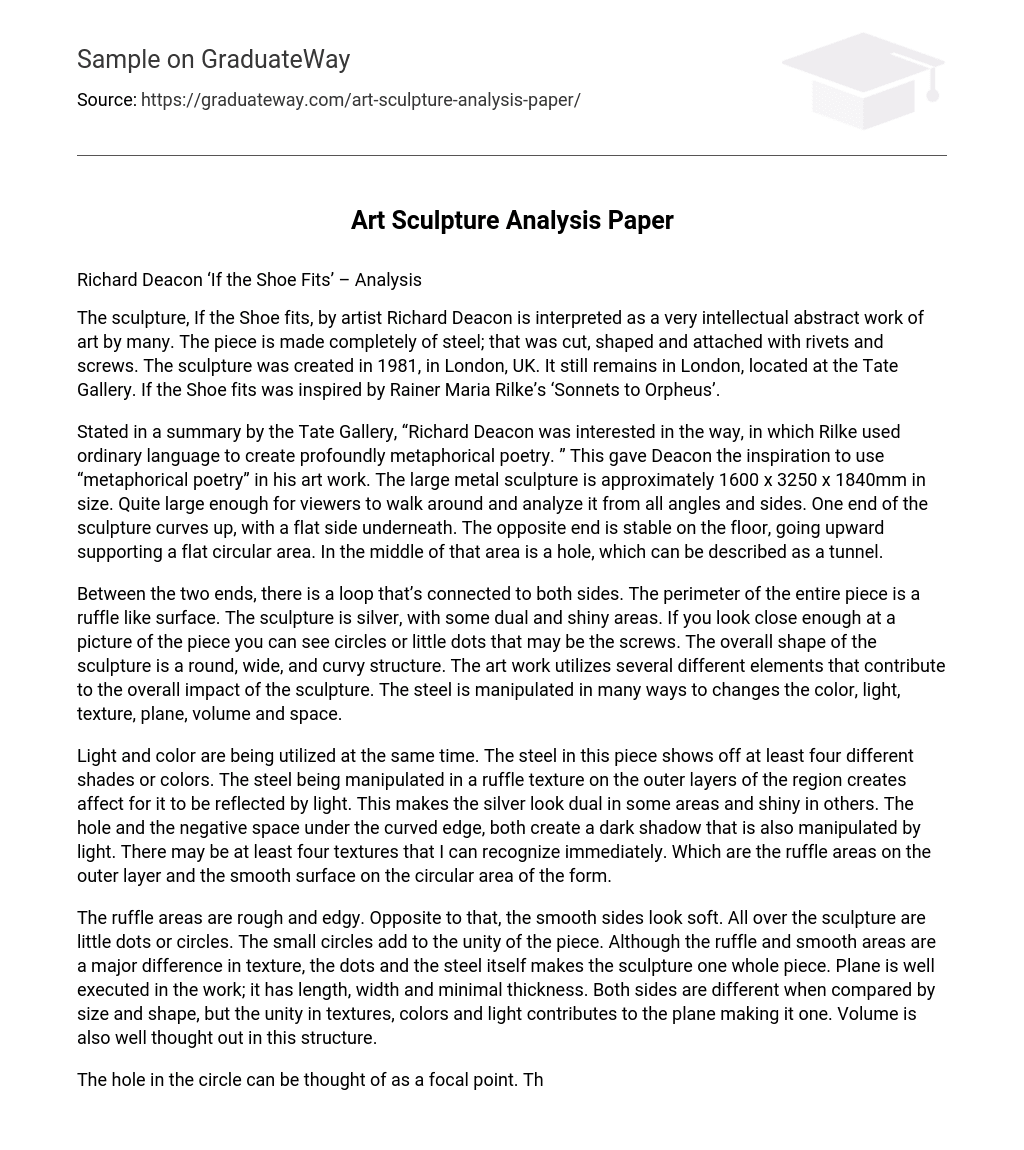Richard Deacon ‘If the Shoe Fits’ – Analysis
The sculpture If the Shoe fits was created by artist Richard Deacon in 1981 in London, UK. It is made entirely of steel and was cut, shaped, and attached with rivets and screws. Many interpret the artwork as a highly intellectual abstract piece. It can be found at the Tate Gallery in London and was inspired by Rainer Maria Rilke’s ‘Sonnets to Orpheus’.
According to the Tate Gallery’s summary, Richard Deacon drew inspiration from Rilke’s use of ordinary language to create profound metaphorical poetry. This influenced Deacon to incorporate metaphorical poetry into his artworks. The sculpture itself measures approximately 1600 x 3250 x 1840mm, providing ample space for viewers to fully examine it from different perspectives. One end of the sculpture features an upward-curving shape with a flat underside, while the other end is firmly grounded and supports a flat circular surface. In the center of this surface, there is a tunnel-like hole.
Between the two ends, there is a loop connecting both sides, creating a ruffle-like surface. The sculpture is silver, with areas that are both shiny and dual in appearance. Upon closer inspection of a picture of the piece, one can observe circles or small dots which may be the screws. The sculpture has a round, wide, and curvy structure. Various elements are employed in the artwork to enhance its overall impact, with the steel being manipulated in multiple ways to alter color, light, texture, plane, volume, and space.
Light and color are simultaneously employed in this piece, as it showcases various shades or colors on the steel material. The manipulation of the steel in the outer layers gives rise to a ruffle texture, which allows for its reflection by light. As a result, the silver color appears dual in some parts and shiny in others. Furthermore, the presence of a hole and negative space beneath the curved edge creates a dark shadow that is also modulated by light. Upon immediate observation, I can distinguish at least four textures, namely the ruffle sections on the outer layer and the smooth surface on the circular area of the structure.
The rough and edgy ruffle areas contrast with the soft smooth sides. Throughout the sculpture, there are small dots or circles which contribute to the unity of the piece. Despite the contrasting textures of the ruffle and smooth areas, the dots and the steel material bind the sculpture together as a whole. The sculpture displays a well-executed sense of plane, with length, width, and minimal thickness. Although the size and shape of both sides differ, the unity in textures, colors, and light results in a cohesive plane. The volume of the structure is also carefully considered in its design.
The hole in the circle serves as a focal point and is the only enclosed space in If the Shoe Fits, effectively utilizing volume and contributing to the overall variety. The sculpture cleverly utilizes space throughout, particularly with the loop that acts as a prominent focal point and contains a significant amount of negative space. The curve at the bottom creates additional negative space, enticing viewers to crawl beneath it and experience the tunnel-like effect, further enhancing the perception of volume. The sculpture itself evokes a sense of exploration and movement as it invites viewers to engage with it. An article describes ‘If the Shoe Fits’ as a metaphorical reflection of contemporary enslavement to fashion, reinforcing its powerful message.
Meaning we walk for miles and miles in our own shoes, but never think about how it would feel to walk in the shoes of others. By using steel for the shoe, Deacon reflects the pain people face in their lives. Seeing that the shoe is made of metal it would be uncomfortable and heavy to wear the shoe. From first glance, the form does not look like a shoe. It is created to be malfunctioned, for the allusion of the shoe being impossible to fit or wear. We all cannot wear each other’s shoe (live each other’s lives), because it is ours to wear (our life to live).
The piece has an upward curve resembling the back of a women’s high heel, while the loop represents a tennis shoe lace. The tunnel-like space within the circle can be compared to where one’s foot goes to put on the shoe. Upon first seeing the sculpture, I was impressed by its uniqueness and creativity. However, it was only after learning the piece’s name and conducting background research that I began to interpret and analyze it differently. I also gained understanding of Richard Deacon’s intended message and the desired interpretation for viewers.
“If the Shoe Fits” is an apt title for this sculpture, as it exudes a sense of dysfunction and contortion that makes one question who could possibly wear such an item. The contrasting textures of smoothness and roughness depicted in this artwork symbolize the various ups and downs that each individual encounters in their life journey. Though we all navigate through different situations in our hectic and chaotic lives, these experiences are uniquely ours and cannot be fitted to anyone else. Ultimately, it is up to us to determine whether or not ‘the shoe fits’.”
Bibliography
- http://www. tate. org. uk/art/artworks/deacon-if-the-shoe-fits-t07321
- http://hexmyex. blogspot. com/2007/09/good-morning-to-you. html





